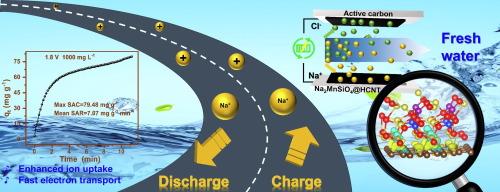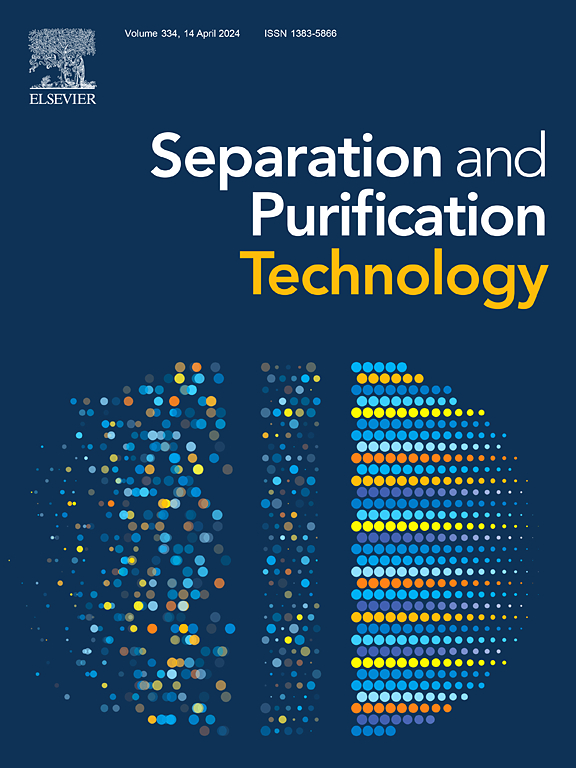Boosting ion uptake and electron transport through bridging Na2MnSiO4 with acidified carbon nanotubes for enhanced hybrid capacitance deionization
IF 8.1
1区 工程技术
Q1 ENGINEERING, CHEMICAL
引用次数: 0
Abstract
The enhancement of ion uptake capacity and electron transport process in the hybrid capacitive deionization (HCDI) Faraday electrode material is achieved by bridging Na2MnSiO4 (NMS) with acidified carbon nanotubes (HCNT). Herein, NMS@HCNT composites with three-dimensional conductive network structure were synthesized by the sol–gel method and subsequent thermal treatment. The NMS@HCNT Faraday electrode material displayed a high desalination capacity of 52.84 mg/g and a satisfactory mean salt adsorption rate of 6.89 mg/g min−1, which are significantly higher than the desalination capacity (30.06 mg/g) and mean salt adsorption rate (4.35 mg/g min−1) of NMS. This excellent desalination performance is mainly attributed to the fact that HCNT in the NMS@HCNT material not only acts as a highway for electron transport, but also increases the specific surface area of the material, which provide more ion-accessible surfaces and active sites to facilitate charge transfer and ion uptake capacity during desalination, thus effectively enhancing the HCDI performance of the electrode material. This study offers valuable insights into the design of HCDI electrode materials for high-efficiency desalination.

通过将 Na2MnSiO4 与酸化碳纳米管桥接,促进离子吸收和电子传输,从而增强混合电容去离子效果
通过将 Na2MnSiO4(NMS)与酸化碳纳米管(HCNT)桥接,可以提高混合电容式去离子(HCDI)法拉第电极材料的离子吸收能力和电子传输过程。本文采用溶胶-凝胶法合成了具有三维导电网络结构的 NMS@HCNT 复合材料,随后进行了热处理。NMS@HCNT法拉第电极材料的脱盐能力高达52.84 mg/g,平均吸盐率为6.89 mg/g min-1,均令人满意,明显高于NMS的脱盐能力(30.06 mg/g)和平均吸盐率(4.35 mg/g min-1)。这种优异的脱盐性能主要归功于 NMS@HCNT 材料中的 HCNT 不仅是电子传输的高速公路,还增加了材料的比表面积,提供了更多的离子可及表面和活性位点,促进了脱盐过程中的电荷转移和离子吸收能力,从而有效提高了电极材料的 HCDI 性能。这项研究为设计用于高效海水淡化的 HCDI 电极材料提供了宝贵的启示。
本文章由计算机程序翻译,如有差异,请以英文原文为准。
求助全文
约1分钟内获得全文
求助全文
来源期刊

Separation and Purification Technology
工程技术-工程:化工
CiteScore
14.00
自引率
12.80%
发文量
2347
审稿时长
43 days
期刊介绍:
Separation and Purification Technology is a premier journal committed to sharing innovative methods for separation and purification in chemical and environmental engineering, encompassing both homogeneous solutions and heterogeneous mixtures. Our scope includes the separation and/or purification of liquids, vapors, and gases, as well as carbon capture and separation techniques. However, it's important to note that methods solely intended for analytical purposes are not within the scope of the journal. Additionally, disciplines such as soil science, polymer science, and metallurgy fall outside the purview of Separation and Purification Technology. Join us in advancing the field of separation and purification methods for sustainable solutions in chemical and environmental engineering.
 求助内容:
求助内容: 应助结果提醒方式:
应助结果提醒方式:


